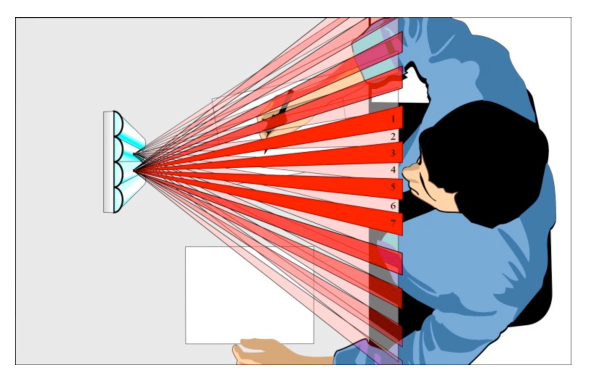The 2D Plus Depth format encrypts the video signal’s 3D left and right views into left and right fields, which are displayed as a left RGB and a Right depth map. This translation of the image’s depth data into a mathematical depth map is a major breakthrough in how 3D images are managed.
The Heinrich-Hertz Institute in Germany, originally developed this methodology under the term, “ Depth Image Based Rendering” or DIBR.
DIBR
DIBR is a math based interpretation of visual data that supports Depth Meta Data algorithm mining of the video data and translation into 256 shades of black and white gray scale depth maps, which are lightweight and re-rendered with every video frame.
In 3DTV displays for With Glasses the classical left and right stereoscopic views are displayed as a Left eye and Right eye view. In NON Philips based AS3D, this same optical format of a left eye and a right eye is “stitched” into a number of left and right multi views, up to 9, which are all based on the original left eye and right eye image.
This “ stitched” approach is a cumbersome, processor heavy and a bandwidth monster of a 3D signal which is “carved in stone”. This means that there is no real time ability to adjust or correct image issues. The 3D quality is determined by the camera capture or content creation. Any 3D image issues which must be corrected require that the content be reworked by going back to the original content and either re-shooting, re-rendering or using post production software tools to try make corrections. This process is very expensive, time consuming and limited in its ability to make corrections with no application for optimization.
The 2D Plus Depth (2D+D) PC driven Math approach revolutionized 3D video technology as it is metaphorically a rocket compared to the classical 3DTV “wheelbarrow” when it comes to 3DTV performance.
2D Plus Depth Format
To decouple content creation from content visualization, a 3D file format is required that can easily be implemented into existing 2D creation and distribution infrastructures. For this, Philips developed the ‘2D-plus-depth’ format. The 2D-plus-depth format comprises additional depth information with every 2D image. The depth information indicates the position of each 2D image pixel on the Z (depth) axis in or out of the screen plane.
This 2D-plus-depth format offers flexibility and compatibility with existing production equipment and compression tools. It ensures 3D application performance within existing distribution mechanisms and standards, with a required bandwidth close to 2D. Moreover it allows applications to use different 3D display screen sizes and designs in the same system.
The heart of the technique is specialized image processing enhanced by a thorough analysis of the content of the image – the motion of objects in the video, their relationships and occlusions. The processing and analysis allow the creation of a depth value for each pixel. The continuity of the temporal aspect in pixel-accurate depth maps is also imposed and controlled. The result is high-quality, temporally-consistent 3D video. Read more


